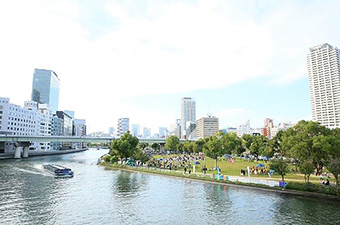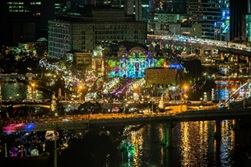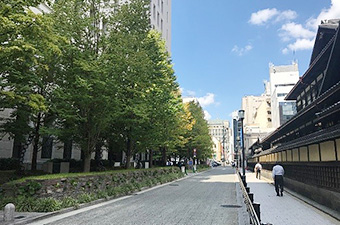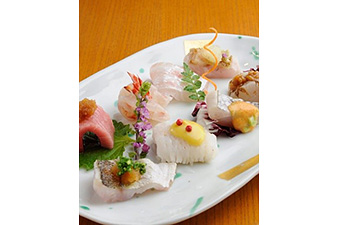Increasing the city’s appeal
Not only does Osaka have tourist resources that have been cultivated over its long history, but it also has the attractiveness of a metropolitan city such as its many choices for food, shopping, entertainment unique to a major vigorous city, and its opportunities for business exchanges. The annual number of overseas visitors to Osaka is 12.31 million (2019 data).
Aiming to establish Osaka as a city attracting more visitors, one which we can proudly boast to the world, the Osaka City Government is creating, improving, and spreading the city’s appeal by leveraging its water-and-light-related attractions, regional resources, and other charming points of interest. Therefore, by designating surrounding areas of Osaka Castle, Tennoji, Nakanoshima, Midosuji, and the Osaka Bay as priority areas, efforts are put into establishing world-class bases for culture and tourism and into developing an environment where tourists can safely stay and go sightseeing with a peace of mind.
Increasing the appeal of Osaka’s water-and-light-related attractions
The Port of Osaka has flourished as a gateway for trade with foreign countries since olden times, and the growth of its economy and culture goes alongside the development of its water transportation in canals and rivers. Since the latter half of 19th century, Osaka is known as the Capital of Water where rivers run through the center of the city in a rectangular shape. Such a landform is rarely seen anywhere in the world and has since been called the Water Corridor.
Focusing on areas around the Water Corridor, the Osaka City Government has been revitalizing Aqua Metropolis Osaka through collaboration among government agencies, businesses, and citizens. As a result, the scenery of Osaka along the rivers is drastically changing. For instance, pedestrian trails and docks are developed along the rivers in the center of the city; cruise lines and commercial facilities such as trendy cafes and restaurants that take advantage of such trails are thus created. In addition, by means such as holding waterfront events, the Water Corridor has been further utilized on a daily basis. Osaka has transformed into the city with the most lively waterfront atmosphere in Japan.
We host the "Festival of the Lights in Osaka" in the winter every year. The area around Nakanoshima, which lies between the Dojima and Tosahori rivers, and Midosuji, one of Osaka's main streets, is illuminated during this event. The event with its impressive light landscape attracted 27.29 million people over the course of 90 days in 2023.
Aqua Metropolis Osaka
URL:https://www.suito-osaka.jp/
-

Lively waterfront at Nakanoshima Park -

Festival of the Lights in Osaka
Spreading Osaka’s appeal utilizing regional resources, etc.
Cultural resources such as traditional arts including
There are also assets such as buildings of great historical and cultural importance remaining in the city. In an area called Semba in which many such assets are located, the Osaka City Government is taking measures such as the removal of utility poles, the development of roads to harmonize with the surrounding landscapes, and the installation of tourist signs, in order to increase the city’s attractiveness for tourism and to provide tourists with a greater sense of ease while traveling.
As for food, Osaka, called
Promoting the gourmet delights by developing high quality, exclusive tourism products and utilize this food culture that only Osaka can offer.
-

Improvements in the Semba District -

Kappo (Japanese culinary art)

